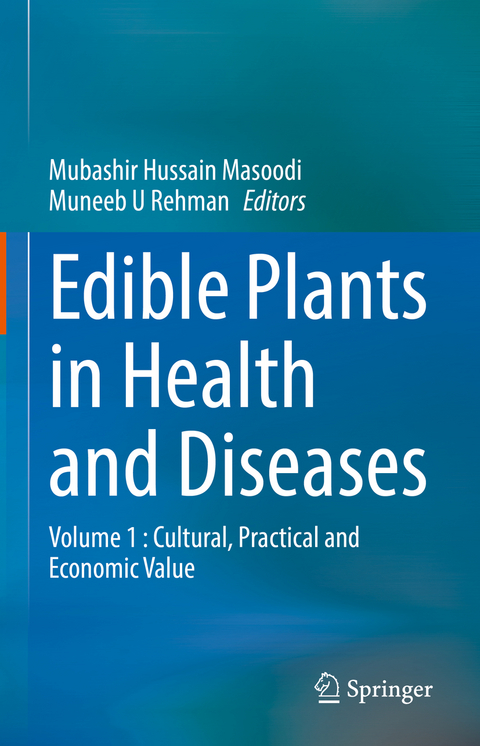
Edible Plants in Health and Diseases
Springer Verlag, Singapore
978-981-16-4879-3 (ISBN)
Dr. Mubashir Hussain Masoodi is presently working as associate professor in the department of pharmaceutical sciences at the University of Kashmir, J&K, India. He holds PhD in pharmaceutical chemistry from School of Pharmaceutical Education & Research (SPER), Jamia Hamdard, New Delhi, India and postdoctoral fellowship from National Center for Natural Products (NCNPR), University of Mississippi, USA. Dr. Masoodi has more than 20 years of teaching and 10 years of research experience and in the field of Natural Product Research. He is the recipient of several national and international fellowships and awards such as Indo-US UGC Raman Postdoctoral Fellowship, Young Scientist Award-2010 by J & K State Council for Science & Technology and best publication award by Indian Drug Manufacturer’s Association (IDMA), Mumbai. He has published more than 75 research papers in peer-reviewed, international journals, and has 3 book chapters to his credit. He is on editorial and review board ofmany reputed high-impact, international scientific journals. Currently, Dr. Masoodi is engaged in isolation of bioactive compounds from medicinal plants, their semi-synthetic modification as well as their screening to check their biological activities for drug discovery. Dr. Muneeb U Rehman is a faculty member at College of Pharmacy, King Saud University, Riyadh, Saudi Arabia. He holds a doctorate in toxicology (specialization in cancer biology and natural product research) from Jamia Hamdard, New Delhi, India. Dr. Rehman has more than 10 years of research and teaching experience in the field of toxicology, biochemistry, cancer biology, natural product research and pharmacogenomics. He is the recipient of several national and international fellowships and awards. He has published more than 100 research papers in peer-reviewed, international journals, and has 3 edited books and 26 book chapters to his name. Dr. Rehman is on the editorial boards and is a reviewer of severalhigh-impact, international scientific journals. Currently, Dr. Rehman is engaged in studying the molecular mechanisms of cancer prevention by natural products and the role of pharmacogenomics and toxicogenomics in evaluating the effectiveness and safety of drugs.
Chapter 1. The Folklore Uses and Economic Importance of Some Selected Edible Medicinal, Plants Native to Oman. A Brief Review.- Chapter 2. Socio-economic Importance of Some Promising Edible Medicinal Plants from (Rajasthan) India.- Chapter 3. Traditional and Economic Valuation of Edible Plants Used for Treatment of Diabetes.- Chapter 4. Cultural and Socio-economic Perspective of Some Promising Edible Plants from Northern Pakistan.- Chapter 5. Medicinal Plants and their Contribution In Socio-Economic Upliftment of the Household in Gurez Valley (J&K).- Chapter 6. Comprehensive overview of Some Edible Medicinal Plants from Kashmir Valley – Cultural, Economic and Pharmacological Importance.- Chapter 7. High Altitude Edible Plants: A Great Resource for Human Health and their Socio-economic Significance.- Chapter 8. Cultural, Practical and Socio-economic Importance of Edible Medicinal Plants Native to Central India.- Chapter 9. Cultural and Scio-economic Perspective of Some Promising EdiblePlants from Uttarakhand Himalaya. Chapter 10. Edible Medicinal Plants from Chhattisgarh (India) and their Economic Significance.- Chapter 11. Ethno-botanical and Economic Significance of Edible Plants Used as Food by Tribal Community of the Western Himalaya.- Chapter 12. Cultural, Practical and Economic Value of Edible Plants used by Mizo Tribes of Mizoram.- Chapter 13. Isoflavones of Soy: Chemistry and Health Benefits.- Chapter 14. Account of Some Important Edible Medicinal Plants and their Socio-Economic Importance.- Chapter 15. Cultural, Practical and Economic Significance of Some Edible Medicinal Plants from Gilgit-Baltistan Pakistan.
| Erscheinungsdatum | 27.01.2022 |
|---|---|
| Zusatzinfo | 1 Illustrations, black and white; XI, 388 p. 1 illus. |
| Verlagsort | Singapore |
| Sprache | englisch |
| Maße | 155 x 235 mm |
| Themenwelt | Medizin / Pharmazie ► Medizinische Fachgebiete ► Pharmakologie / Pharmakotherapie |
| Medizin / Pharmazie ► Pharmazie | |
| Naturwissenschaften ► Biologie ► Biochemie | |
| Naturwissenschaften ► Chemie ► Organische Chemie | |
| Technik ► Lebensmitteltechnologie | |
| Schlagworte | Anti-cancer • Antioxidants • edible plants • Human health • pharmacology • Phyto-chemicals |
| ISBN-10 | 981-16-4879-4 / 9811648794 |
| ISBN-13 | 978-981-16-4879-3 / 9789811648793 |
| Zustand | Neuware |
| Informationen gemäß Produktsicherheitsverordnung (GPSR) | |
| Haben Sie eine Frage zum Produkt? |
aus dem Bereich


